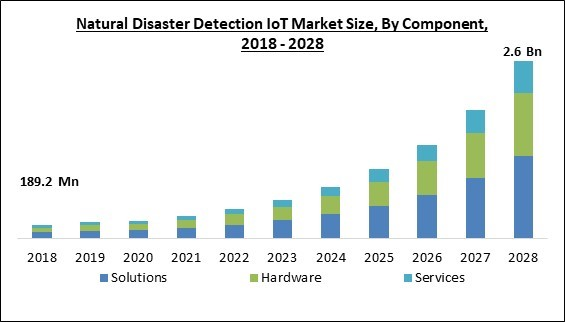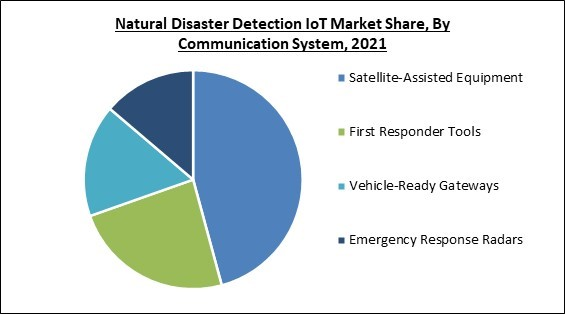The Global Natural Disaster Detection IoT Market size is expected to reach $2.6 billion by 2028, rising at a market growth of 35.3% CAGR during the forecast period.
Natural disaster detectionIoT is an emerging field that provides real-time information before, during, and after natural catastrophes using sensor and satellite technology. Data about natural disasterevents are tracked and monitored. For instance, sensors can monitor highways with downed power lines and the rate of a forest fire's spread. Natural disasters include extreme climate and weather conditions.
Some areas are more susceptible than others to specific hazards, even though they exist everywhere in the world. When livelihoods and livesare lost, natural disasters turn into catastrophes. It is possible to protect lives and property by providing clear predictions and warnings in an easily understandable format as well as by instructing individuals on how to prepare for such threats before they become disasters.
The focus is on reducing the likelihood of a disaster; one dollar spent on preparedness can stop seven dollars in economic losses caused by disasters, representing a large return on investment. It is expected that US$314 billion will be lost annually in the built environment due to floods, earthquakes, tsunamis, and tropical cyclones (storm and wind surges). The international objective of sustainable development faces a significant threat from this issue. Most of the world's largest, highest-income, and most risk-exposed economies account for the average annual loss in absolute terms from natural disasters.
The cutting-edge technology Internet of Things (IoT) envisions a worldwide internal network of intelligent physical items. The IoT is a promising technology with many uses, including disaster management. IoT plays a huge, pervasive, and potentially life-saving role in natural disaster detection. Reliable environmental monitoring systems with quick alerting capabilities are required, given that natural disasters will increase in future because of climate change. In addition to causing fatalities and property damage, these weather-related disasters harm economies and ecosystems.
The market research report covers the analysis of key stake holders of the market. Key companies profiled in the report include SAP SE, NEC Corporation, BlackBerry Limited, Semtech Corporation, OnSolve LLC, One Concern, Inc., OgoXe, Sadeem Technology and Earth Networks, Inc. (Advanced Environmental Monitoring LLC).
Natural disaster detectionIoT is an emerging field that provides real-time information before, during, and after natural catastrophes using sensor and satellite technology. Data about natural disasterevents are tracked and monitored. For instance, sensors can monitor highways with downed power lines and the rate of a forest fire's spread. Natural disasters include extreme climate and weather conditions.
Some areas are more susceptible than others to specific hazards, even though they exist everywhere in the world. When livelihoods and livesare lost, natural disasters turn into catastrophes. It is possible to protect lives and property by providing clear predictions and warnings in an easily understandable format as well as by instructing individuals on how to prepare for such threats before they become disasters.
The focus is on reducing the likelihood of a disaster; one dollar spent on preparedness can stop seven dollars in economic losses caused by disasters, representing a large return on investment. It is expected that US$314 billion will be lost annually in the built environment due to floods, earthquakes, tsunamis, and tropical cyclones (storm and wind surges). The international objective of sustainable development faces a significant threat from this issue. Most of the world's largest, highest-income, and most risk-exposed economies account for the average annual loss in absolute terms from natural disasters.
The cutting-edge technology Internet of Things (IoT) envisions a worldwide internal network of intelligent physical items. The IoT is a promising technology with many uses, including disaster management. IoT plays a huge, pervasive, and potentially life-saving role in natural disaster detection. Reliable environmental monitoring systems with quick alerting capabilities are required, given that natural disasters will increase in future because of climate change. In addition to causing fatalities and property damage, these weather-related disasters harm economies and ecosystems.
COVID-19 Impact Analysis
The demand for IoT goods for natural disaster detection wasimpacted by several nations' high inflation rates brought on by the pandemic. As a result, market participants increasingly invested in goods that offer long-term cost savings and increased accuracy rates compared to conventional ways of studying possible dangers from disasters like earthquakes or floods. Furthermore, due to rising demand, businessesinvestedsubstantially in R&D to provide novel solutions with higher accuracy levels at a lower price. Therefore, the pandemic positively impacted the natural disaster detection IoT market.Market Growth Factors
Growing utilization of sensors and IoT devices to foresee disasters
The National Oceanic and Atmospheric Administration (NOAA) in the United States has set up a network of IoT sensors to monitor tsunamis and other natural disasters. Likewise, the government of Japan has put in place an early warning system for earthquakes that uses IoT sensors to find seismic activity and alert the public. In addition to these instances, numerous organizations and governments are investigating the application of IoT for the detection and response to natural disasters. Therefore, as IoT technology develops and becomes more widely available, more governments will implement these systems for efficient disaster detection, resulting in market growth.Increased reliance on satellite remote sensing and geographic information systems (GIS)
GIS makes it possible to combine different forms of spatial data with other types of data (including non-spatial data), and it also makes it possible to combine different kinds of attribute data with spatial data. These combinations can then provide useful information for the various disaster management and detection phases. Using GIS, requirements for emergency management can be determined in advance of an incident. This contributes to the mitigation and reduction of potential disaster risks. Therefore, the increasing use of these technologies facilitates market advancement.Market Restraining Factors
IoT device vulnerabilities, along with a lack of skilled personnel
IoT devices are becoming more diverse and plentiful due to industry improvements. Every internet-connected gadget, including smartphones, computers, and wearables, functions as a node within an international hazard-tracking system. Each IoT device may serve as a sensor, identifying the local atmospheric conditions and sending crucial information to experts studying natural disasters. However, the rapid evolvement of new IoT devices have increased the frequency of security flaws. If it any device or system fails, it raises significant hazards due to increased security vulnerabilities of IoT devices. All of these factors are hampering the growth of the natural disaster detection IoT market in the coming years.Component Outlook
Based on component, the natural disaster detection IoT market is categorized into hardware, solutions, and services. The solutions segment garnered the highest revenue share in the natural disaster detection IoT market in 2021. IoT solutions provide corporate applications that boost operational effectiveness, improve customer satisfaction, and create new prospects for generating income. IoT devices that are internet-connected easily communicate data with one another, work together to run apps and offer reliable data decisions to the user. In addition, wide-ranging technologies provided by solutions help in monitoring natural disasters.Application Outlook
On the basis of application, the natural disaster detection IoT market is divided into flood detection, wildfire detection, landslide detection, earthquake detection, weather monitoring, and others. The wildfire detection segment acquired a substantial revenue share in the natural disaster detection IoT market in 2021. Increasing wildfires are more intense and is emerging as a major problem worldwide. Throughout the past few years, there have also been large fires that have erupted in Australia, the Amazon, the US, etc. As a result, many companies and other businesses are creating IoT devices that use wireless sensors to provide advanced warnings of wildfire danger.Communication System Outlook
Based on communication System, the natural disaster detection IoT market is segmented into first responder tools, satellite-assisted equipment, vehicle-ready gateways, and emergency response radars. The satellite-assisted equipment segment witnessed the largest revenue share in the natural disaster detection IoT market in 2021. In order to lessen damage and fatalities during emergencies and natural disasters, satellite service providers have long assisted in forecasting, mapping out, and delivering real-time information. Most satellite-based disaster management techniques have depended on evaluating the most recent photos individually.End-user Outlook
On the basis of end user, the natural disaster detection IoT market is classified into government organizations, private companies, law enforcement agencies, and rescue personnel. The rescue personnel segment acquired a significant revenue share in the natural disaster detection IoT market in 2021. Rescue operations are aided by improved communications networks. In addition to monitoring post-disaster conditions and stockpile levels of vital resources, IoT devices can assist in search and rescue efforts. When standard communications continue to be fixed, IoT can be utilized to continue disseminating information to the general population.Regional Outlook
Region wise, the natural disaster detection IoT market is analyzed across North America, Europe, Asia Pacific, and LAMEA. The North America segment recorded the highest revenue share in the natural disaster detection IoT market in 2021. Many natural disasters have affected North America, including earthquakes, mudslides, flooding, hurricanes, droughts,tornadoes, and tsunamis. Because of the destruction of expensive properties, infrastructure, and the environment, these scenarios significantly impact finances and human lives.The market research report covers the analysis of key stake holders of the market. Key companies profiled in the report include SAP SE, NEC Corporation, BlackBerry Limited, Semtech Corporation, OnSolve LLC, One Concern, Inc., OgoXe, Sadeem Technology and Earth Networks, Inc. (Advanced Environmental Monitoring LLC).
Scope of the Study
By Component
- Solutions
- Early Warning System & Floating Sensor Network
- Lightning Detector System & Acoustic Real-Time Monitoring System
- Beacons & Others
- Hardware
- Services
By Application
- Flood Detection
- Wildfire Detection
- Weather Monitoring
- Earthquake Detection
- Landslide Detection
- Others
By Communication System
- Satellite-Assisted Equipment
- First Responder Tools
- Vehicle-Ready Gateways
- Emergency Response Radars
By End-user
- Government Organizations
- Law Enforcement Agencies
- Private Companies
- Rescue Personnel
By Geography
- North America
- US
- Canada
- Mexico
- Rest of North America
- Europe
- Germany
- UK
- France
- Russia
- Spain
- Italy
- Rest of Europe
- Asia Pacific
- China
- Japan
- India
- South Korea
- Singapore
- Malaysia
- Rest of Asia Pacific
- LAMEA
- Brazil
- Argentina
- UAE
- Saudi Arabia
- South Africa
- Nigeria
- Rest of LAMEA
Key Market Players
List of Companies Profiled in the Report:
- SAP SE
- NEC Corporation
- BlackBerry Limited
- Semtech Corporation
- OnSolve LLC
- One Concern, Inc.
- OgoXe
- Sadeem Technology
- Earth Networks, Inc. (Advanced Environmental Monitoring LLC)
Unique Offerings
- Exhaustive coverage
- The highest number of Market tables and figures
- Subscription-based model available
- Guaranteed best price
- Assured post sales research support with 10% customization free
Table of Contents
Chapter 1. Market Scope & Methodology
Chapter 2. Market Overview
Chapter 3. Global Natural Disaster Detection IoT Market by Component
Chapter 4. Global Natural Disaster Detection IoT Market by Application
Chapter 5. Global Natural Disaster Detection IoT Market by Communication System
Chapter 6. Global Natural Disaster Detection IoT Market by End-user
Chapter 7. Global Natural Disaster Detection IoT Market by Region
Chapter 8. Company Profiles
Companies Mentioned
- SAP SE
- NEC Corporation
- BlackBerry Limited
- Semtech Corporation
- OnSolve LLC
- One Concern, Inc.
- OgoXe
- Sadeem Technology
- Earth Networks, Inc. (Advanced Environmental Monitoring LLC)
Methodology

LOADING...










